Faster and Easier
Ah, a new Honda literbike. Lighter, of course. Faster, too. And with a bit more than 110 horsepower making its way to the rear wheel, this CBR is a rocket!
“Huh? Dude, the 2008 CBR1000RR better have more power than that!”
Indeed it does, but I was flashing back a decade to the first press launch of my motojournalist career. The changes made to the 1998 CBR900RR made it the best big CBR ever, and I was awed by how fast yet controllable that new scalpel was.
Now, a little more than 10 years later, I’m again in the seat of the best literbike Honda has yet crafted. Compared to the RR I rode in ’98, it weighs less and has nearly 50 additional horses.
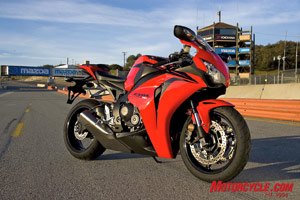
New from the ground up, the 2008 Honda CBR1000RR performs better than its predecessor in every way.
Mazda Raceway Laguna Seca was the estimable location this time around, and my day lapping the historic NorCal circuit proved this clean-sheet-design double-R performs at a level beyond its two-year-old predecessor, never mind the seemingly docile 10-year-old one. I came into this sessions already thrilled with the stellar new ZX-10R Kawasaki I rode last month in Qatar. To even rank in that league, the CBR needed to be something special. It is.
A phalanx of CBRs with tire warmers sit on stands, resplendent in five different color combinations, greeted us sitting in the same pit stalls the MotoGP teams use each July. This ’08 model, dubbed internally as MFL (previously the MEL), has a countenance that polarizes opinions. Gone are most of the sharp creases of the MEL, replaced with arching curves that suggest a more organic bent. Some dig it; some don’t.
Up front is a snubby nose that mimics the abbreviated proboscis of the RC212V MotoGP bike, something Honda says makes for easier steering transitions at speed. Dual ram-air ducts below the rounder headlights route cool airflow through the frame rails rather than the solo center-mount design of the 600RR. The new CBR1K’s rear area looks light and airy thanks to the relocation of the former bike’s underseat exhaust to a bulky unit somewhat camouflaged under the engine.
|
It turns out that one of the Honda men instrumental to aiding Nicky Hayden in his MotoGP championship year in 2006 is also indispensable to the fun you can have on the new CBR1000RR. And he’s probably the only rider to have ever crashed an RC211V in the snow! Kyoichi Yoshii, the Test “Large Project Leader” for this CBR, came to this assignment after he was the project leader of Nicky Hayden’s RC211V in the American’s MotoGP championship year in 2006. While this might seem like a demotion, Yoshii didn’t see it that way. He told me over dinner that he enjoys bringing to market vehicles that the general public wants and enjoys. In the contemporary streetbike world, just like in MotoGP, a sharper focus is being brought upon achieving the best possible drivability out of an engine, not just producing gobs of peak power. As such, various rider aids are helping make fire-breathing literbikes a little less monstrous, and that’s why this is the first CBR to receive a slipper clutch and why it has the IACV air-bleed valves in the fuel-injection system – they help make it easier to ride. As much as Yoshii is a huge performance enthusiast, he recognizes that there isn’t much point in developing bigger horsepower numbers from streetbikes. He wants to make them so they’re more manageable. That being the case, I asked him if Honda might consider altering a four-cylinder engine’s even firing order in favor of one that ignites its cylinders more closely spaced like GP machines and those in the British Superbike series, which kind of mimics the delivery of a V-Twin engine. “If we want to build a V-Twin, we’ll make one,” Yoshii responded with a smile. And what about crashing that MotoGP bike in the snow? Yoshii was conducting some testing at a Honda facility in Japan, and he was making runs on a straightaway that was cleared of recent snow. Well, on one run he missed his braking marker and couldn’t get it slowed in time, plowing into the white stuff in the run-off area! |
Anyway, the CBR’s nothing more than a blur if you’re watching it rocket up Laguna’s front-straight, accelerating so quickly that you’d swear it would get air under its wheels if its pilot had the cojones to keep the throttle pinned over the crest of the hill. This newest CBR has some stones of its own, hurtling out of corners with the addictive thrust of a mighty literbike.
Last year’s CBR trailed the pack in terms of peak power, so Honda threw out the old 998.6cc inline-Four and built a new 999.8cc version. (C’mon, guys, you’re giving up 0.19cc while remaining below the 1000cc limit!) Its bore has gone up 1mm while its stroke is 1.5mm shorter than before. Also new are titanium intake valves, slightly larger than previous. Cams are lighter by 1.1 lb thanks to a new, chilled, thin-wall, ductile steel casting process that allows a reduced wall thickness, and its cylinder head is narrower by 15mm and lighter. Overall, the engine has lost more than 5 lbs.
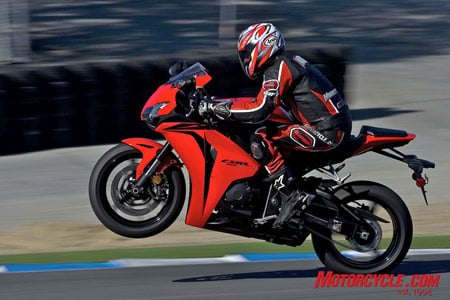
The new CBR has more ponies up top, which is always nice, but even more satisfying is buckets of midrange grunt that might be the best in its class.
Getting Honda representatives to divulge closely held information is easier than getting al-Qaeda to talk, but not by much. Still, a short waterboarding session revealed this new 1000RR is pushing nearly 7% more power. Our 2007 CBR test bike cranked out a rather modest 148 hp, so we expect this new one to spit out nearly 160 hp at its rear wheel.
It can now run with the big dogs at the track. But even more impressive from a seat-of-the-pants perspective is the bump in midrange power. The’07 bike was at or near the top of the pack in terms of twist below 9000 rpm, but this new CBR easily puts the old one on the trailer. It was rather impressive to have the front wheel soar off the ground in a controllable power wheelie while exiting the second-gear Turn 3, no squidly clutch dump required.
| |
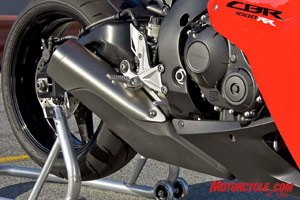 Honda abandoned the old CBR’s “Center Up” undertail exhaust in favor of this bulky unit under and behind the engine. It’s the shape of things to come. |
| Ever since the Ducati 916 debuted in 1994, routing an exhaust system underneath a seat was seen as the coolest way to do it. It left the rear wheel nicely exposed, and it forever prevented ground clearance issues with mufflers. Eventually, all the Japanese OEMs except Suzuki tried this arrangement on various sportbike models. Meanwhile, about the time of the Ducati’s unveiling, Erik Buell was developing Harley-engined sportbikes with their mufflers mounted under their engines. How odd, we all thought. Well, Mr. Buell must have several “I-told-you-so” moments in the past few years. Variations on the under-engine exhaust theme have been riffed on by Yamaha, Suzuki and now Honda. Placing anything that heavy up so high and away from the bike’s center of gravity was always going to be a compromising situation, especially as emissions regs require a heavy catalyzer. Honda’s CBR600RR combats this problem by using titanium innards for its underseat muffler, reducing weight as much as possible from this critical location. According to Honda, the use of expensive Ti adds about $200 to the canister’s cost. On the other hand, this new 1000RR uses an under-engine exhaust in which its complexities (a three-path chamber configuration with a pressure-controlled valve working in conjunction with an electronic valve) are neatly tucked away. Just as important, it contains no titanium, helping keep the price increase on this new model to just $100. |
Freddie Spencer, a multi-time world champ roadracer who was at the event, stresses in his High Performance Riding School how important it is to make smooth transitions when riding a bike near its limit. And this is something Jon Row, American Honda’s Manager of Motorcycle Press, reminded the assembled journalists. “The thing that separates a good rider from bad is their ability to make smooth transitions,” he said, adding that the 23 patents filed for the CBR is “technology to assist transitional technique.”
First seen on last year’s CBR600RR, the IACV (Idle Air Control Valve) is basically an air-bleed valve that allows some air to be introduced downstream of throttle valves. This apparently “improves previously unstable combustion” to minimize abruptness when applying throttle or coming off it by allowing some intake air to bypass the 46mm throttle bodies, also slightly reducing engine braking.
Further aiding smooth braking transitions is perhaps the best slipper clutch I’ve yet sampled. A clutch that limits back-torque during high-rpm downshifts while braking is nothing new, but this one works seamlessly and has an ingenious design.
There are two problems with most slipper clutches: they are heavy and they require stiff clutch springs, the latter resulting in a heavy lever pull. But this new patented design developed with Japanese company FCC uses cams that apply a tighter squeeze on the clutch plates while under acceleration, thereby allowing moderate rates for the clutch springs. Creating a lighter lever pull allowed for a cable-actuated design instead of a hydraulic unit that is heavier.
'Creating a lighter lever pull allowed for a cable-actuated design instead of a hydraulic unit that is heavier.'
Ignition Interrupt Control is brand-new technology unique to the CBR1K. Nope, it’s not a form of traction control. Instead it’s an electronic way to reduce drivetrain lash felt when reapplying throttle. The IIC determines the change from deceleration to acceleration based on throttle position, crank speed and countershaft speed, and it cuts the ignition for a brief 20ms when engine speed exceeds countershaft speed, reducing driveline shock. It’s a clever system, though it works only up to 6000 rpm and only at small throttle openings.
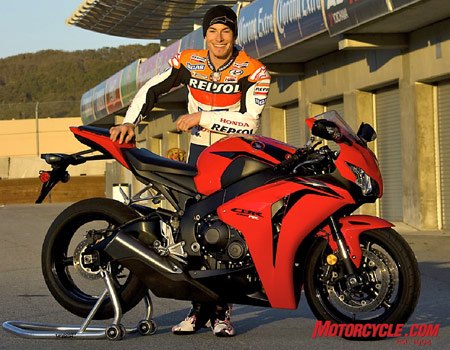
Here’s a guy who knows a thing or two about smooth transitions. Nicky Hayden, the 2006 MotoGP world champion, stopped by Laguna Seca for a quick spin aboard the new CBR.
Out on the track, I wasn’t thinking much about the gizmos working seamlessly below me. But once I sampled an ’07 CBR brought for comparison, I can say with authority that this new bike is way easier to ride smoothly. The old bike proved to be much more abrupt in its throttle transitions, and this was exacerbated by its lack of slipper clutch.
Riding the previous version back-to-back also gave excellent insight into other nuances. The new bike’s handlebars are just 6.5mm higher than in ’07, which doesn’t sound like much, but their taller position is instantly noticed and appreciated (though I can’t say the same about them also being 2mm further forward).
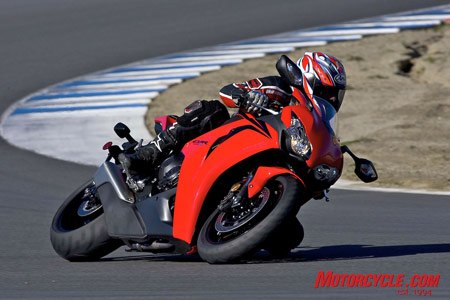
A three-way combo of slipper clutch, Idle Air Control Valve and Ignition Interrupt Control combine to help make a rider smoother.
The ’08 also feels slimmer through its midsection, as its frame spars are 1.2 inches closer together. Now using the same Hollow Fine Die-cast as its 600cc little brother, the aluminum frame consists of just four pieces instead of nine. Although the structure is 5.5 lbs lighter, Honda says rigidity is up in all three axes: 40% laterally; 13% torsionally; and 30% at longitudinally.
Out on the twists and turns of Laguna, the old bike feels less responsive. Part of the newfound agility is due to slightly more aggressive chassis geometry: 23.3-degree rake; 96mm trail; 55.4-in. wheelbase. Honda also deserves credit for lopping off more than 1 pound from its new, thinner-wall aluminum wheels – a significant amount in this crucial area. The result is a bike that feels shorter and steers quicker.
| |
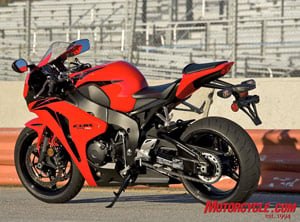 At 435 pounds ready to ride and full of fuel, the new CBR1000RR is Honda’s lightest literbike ever. |
| Most manufacturers provide their claimed dry weights by adding up the mass of each component of the bike. This not only ignores fuel, oil, engine coolant, grease, etc., it also may not include every nut and bolt and washer. As such, the OEM’s claimed dry weights are often wildly optimistic and bare little resemblance to reality. Last year, Honda became the first manufacturer to pull out of the crazy “dry weight” claims among the OEMs. Since 2007, Honda has been providing a fuelled-up, ready-to-ride weight in its published specifications. And this apparently includes the tool kit and owner’s manual! Below is a rundown of some of the fully fueled weights of CBRs over the years. 1993 CBR900RR: 455 lbs 2003 CBR600RR: 445 lbs (2007 CBR600RR: 410 lbs) 2004 CBR1000RR: 469 lbs 2006 CBR1000RR: 452 lbs 2008 CBR1000RR: 435 lbs |
A total of 17 lbs has been trimmed from the old CBR. According to Honda, its new literbike weighs 17 to 35 lbs less than any of its ’07 rivals. At 435 lbs full of fuel, the new 1000RR is actually a full 10 lbs lighter than the 2003-04 CBR600.
The CBR’s suspension is the least changed aspect of the bike. The three-way adjustable shock is similar to previous, although the ’08 version is worked by a completely new swingarm. Up front is another 43mm inverted Showa fork, although its stanchions are now 10mm closer together for a slimmer front profile to go along with the skinnier frame and narrower/taller radiator. (Interestingly, the CBR900RR I rode in ’98 boasted of fork tubes 10mm wider for added rigidity.)
Also of note is the absence of dual-speed compression damping adjustability as seen on many current sportbikes, and the fork sliders are devoid of expensive low-friction coatings such as titanium-nitride or DLC. Despite this cost cutting, the CBR’s suspension action was perfect on the relatively smooth surface of Laguna Seca, and we expect its performance on the street will be quite good as is typical from Honda.
One damper that did get an upgrade is the Honda Electronic Steering Damper, and it’s integral to producing a sharp-steering bike with the requisite amount of assuring steadiness. “We couldn’t make this bike without this technology,” said a Honda rep.
First seen on the 2004 model, the high-tech HESD stabilizer electronically increases its damping force in response to the bike’s speed and acceleration. Now smaller and lighter, the damper is nicely unobtrusive at low speeds, and I must say I was impressed that nothing sketchy ever happened – even when landing third-gear wheelies on Laguna’s front straight near the pedestrian bridge.
The HESD became even more important after we switched from the stock Dunlop Qualifier tires (120/70-17 up front and a 190/50-17) to Dunlop’s D211GP, a race-compound tire that’s so new that you can’t even buy it yet. (It’s a sweet deal when legendary tire expert Jim Allen and an entire Dunlop crew come out to support your trackday!). The D211 is an evolution of the successful D209GP NT. Like most race rubber, the front tire is more triangular than a street-oriented profile, and this resulted in the sharp-steering CBR responding noticeably quicker. Outright grip from the new buns is phenomenal.
When it’s time to slow down, the CBR drops anchor via a totally new setup. The front calipers are now a one-piece “monoblock” design which is more rigid and lighter than a bolt-together component. Instead of the old caliper’s four steel pistons, the new clampers contain four aluminum slugs. This combines to axe almost 1 pound from the weight of the old calipers. A lighter carrier for the twin 320mm front discs also pares weight. Their performance was quite good, hindered only by a slightly spongy feel through the rubber brake lines. Japanese OEMs are reluctant to use steel lines, as they are afraid sloppy riders could end up on their ears if the brake response is too immediate.
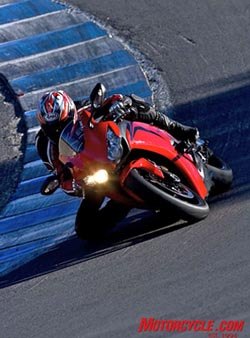 With almost 20 fewer pounds and slightly more aggressive steering geometry, the new CBR has cooperative agility that is apparent while flip-flopping down Laguna’s famous corkscrew. | 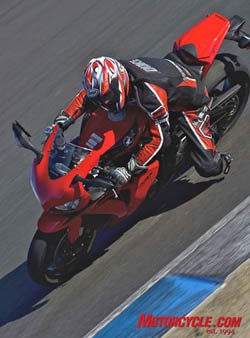 Honda has done the improbably by delivering a faster and more responsive bike that is somehow easier to ride. |
|
With all the buzz in the media about which 1000cc sportbike is best, you might think ZX-10s and R1s are flying off the showroom floors as the class becomes more popular than ever. Actually, it turns out that literbike sales haven’t been keeping pace with the overall sportbike market over the past several years. It’s the 600 class that rules. During the years from 2004-06, sales in the sportbike market shot up nearly a massive 25%, nudging the 185,000-unit threshold. Over that same period, literbike sales surprisingly stayed mostly flat, just cresting the 40,000 mark. “We’re hoping to change that with this model,” smiled Jon Seidel, Honda’s Assistant Manager, Motorcycle Press. Honda’s 2006-7 CBR1000RR did quite well in the showroom shootouts. Big Red sold 20,000 of them over the two years, which was second only to a certain other Japanese literbike. Honda neglected to mention the best-selling machine, but it’s a safe bet to say that its name rhymes with jixxer. |
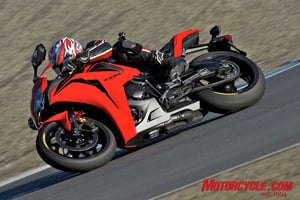
The 2008 CBR1000RR is one of the greatest literbikes ever, and it will be gunning for top spot in our annual literbike shootout.
In The Seat
Let’s summarize the riding experience of the new CBR by taking a ride with me along the last two corners of Laguna Seca. Turn 10 is a fast third-gear corner that demands an aggressive turn in, and the RR responds with alacrity. Front-end feel is quite good as the pavement scuffs my right boot from a perilous lean angle that nonetheless doesn’t drag a peg. Picking up the throttle after the corner’s apex is a smooth, non-lurchy experience thanks to the IACV, allowing an early drive out of the corner and down to the slow-speed Turn 11.
Then, as late as you dare, grab a handful of front brake from the potent radial-mount setup while banging down a couple of gears. Sloppy, mismatched downshifts are eaten up by a superb slipper clutch, making entry into the first-gear Turn 11 a stable affair. This left-hand corner leads onto the front straightaway, so it’s important to quickly throw the CBR on its side and then get it stood up for an expedient exit.
Dialing up the power, the CBR responds without abruptness and with intense thrust. There’s enough accessible power to tractor out of the corner in second gear, but it’s more exciting to get on the gas in first gear with the bike still leaned over slightly and float the front tire off the ground through first gear and into second, snagging a well-timed upshift thanks to a programmable shift light on the highly legible gauges.
In case I haven’t yet made it perfectly clear, this 2008 CBR1000RR is the best liter-sized Honda ever, and that’s really saying something. It’s as fast as hell and very agile, but its most notable feature is how manageable a blazing Superbike like this can be. I’d never recommend a literbike to a sportbike neophyte, but you could do much worse than this CBR.
Get ’em at your dealer in March for an MSRP of $11,599. A special edition Black/Metallic Grey costs an extra $200 and is limited to less than 500 units.
| The Perfect Bike For... | ||
| Fans of Nicky Hayden and Honda who demand the latest and greatest, delivered in a livable and cooperative package that can go toe-to-toe with anything. | ||
| Highs: | Sighs: | |
|
| |
|
| ||
| | ||
|
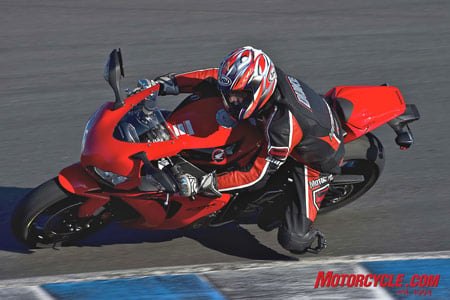 | ||
| ||


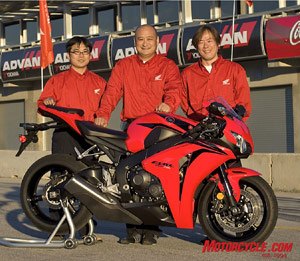
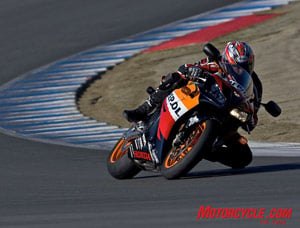

Tidak ada komentar:
Posting Komentar